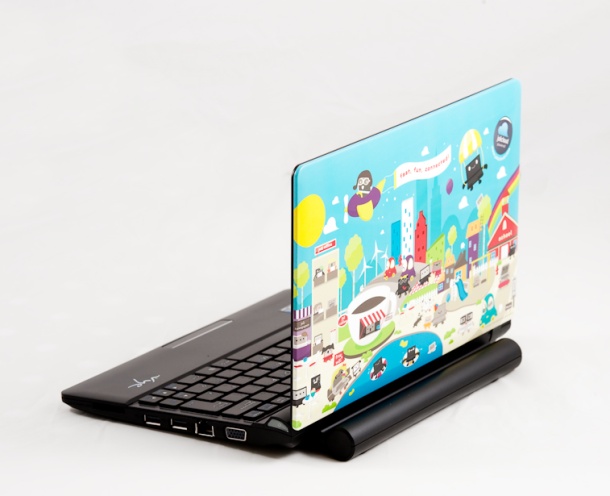Hands-on with Jolicloud's slightly confusing Jolibook

I am rather enamoured with the Jolicloud operating system. It's a very clever mix of HTML5 front end, Linux back end and cloudy filling.
It's definitely a good bet as a replacement for the rather rubbish Starter Edition of Windows 7 that comes preinstalled on most netbooks these days. Now the French company behind the OS has released its own netbook, the Jolibook, and while I am fairly impressed with the device I still do not understand why it exists.
The Jolicloud 1.1-equipped Jolibook has a decent spec, but what's it for? Photo credit: Jolicloud
Let's start at the start. I'm not going to go into Jolicloud itself — you can read this piece for my take on that — but will talk instead about the hardware and the whole package. What we have here is an up-to-date, if mostly bog-standard, late-2010 netbook: 10-inch screen, 250GB hard drive, 1GB RAM, dual-core Atom processor. Except for the lid, which is most... colourful. It's a bit Marmite, that lid — the cartoon tableau of Joli-themed stuff may work for kids and the perennially ironic, but it's hardly an enterprise play.The netbook runs really fast. I'll put that down to Jolicloud rather than the processor, as Intel's N550 is clocked at a modest 1.5GHz. It turns on and shuts down quickly, and the dual-core nature of the N550 means multiple apps can happily coexist.
This certainly beats Windows 7 Starter Edition in terms of netbook-friendliness. Frustratingly, though, it does not beat it on price — the Jolibook costs £280, but a perfectly capable, N550-toting Acer Aspire D255 can be had for £30 less. The Acer comes with Windows 7 Starter Edition, which costs money, whereas Jolicloud is free. So why does the Jolibook not cost less?
The hardware is mostly decent. The Jolibook is actually made by the not-terribly-well-known manufacturer Vye, and they've stuck in a very good chiclet keyboard, a bright screen and all the connections you'd hope to have. I wish the screen had a higher resolution than the standard 600-pixel-high netbook res, but you can't have everything.
I have two complaints about the hardware, though: the touchpad and the battery. The former is a standard, Asus-style dimpled job, but it seems to flake out every once in a while, sending the cursor skipping across the screen or not doing very much at all. The 4400mAh, six-cell battery sticks out like a much more high-capacity affair and, worse, it rattles slightly. That said, the way it protrudes actually makes for a pleasing typing angle when on a flat surface, so it may be a matter of taste.
So, would I recommend the Jolibook? Depends who you are — as I said before, it's hardly sophisticated in appearance — but, generally, no. Jolicloud is an awesome OS, and stands a chance of beating Chrome OS at its own game (seeing as you can install it today), but you can just install it on any other netbook.
This is why I'm confused. As Jolicloud chief Tariq Krim puts it himself, Chrome OS is more suitable for new computers and Jolicloud is for reviving older machines. The Jolibook may be a marketing exercise, designed to promote the underlying OS, but it's a risky one — not that Jolicloud is obliged to give numbers, but poor sales of the Jolibook could lead to people seeing the OS itself as a flop.
If you do have a new or recent netbook, I urge you to give Jolicloud a try. It finally hit version 1.1 yesterday (you can now customise the HTML5 launcher), it's a lot of fun and it feels like the future. If you're in the market for a new netbook, though, I'd recommend buying a standard Windows 7 SE affair and deciding between Microsoft and Jolicloud (or having both boot options) after that.
PS - I seem to have broken the screen on my loaner Jolibook (was carrying it in my bag, which knocked against a wall), and I must say I am rather annoyed at this turn of events. Personally, I rather like the garish lid etc... it really is a matter of taste!